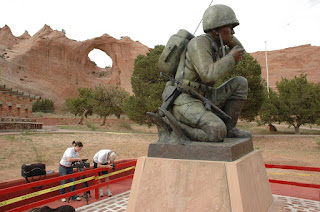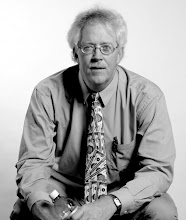I think we succeeded in tiring-out everyone in our group today.
We left the Diné College campus at 8:30 a.m. on our way to Window Rock, the capital of the Navajo Nation, for a day filled with tours to help us understand the media and government on the reservation, and a visit to the Navajo Nation Museum.
Our first stop was at the Tribal Government Center, where we met with George Hardeen, chief press secretary for Joe Shirley, President of the Navajo Nation. George was a professional journalist for many years, both in print and broadcast. A few years ago, Pres. Shirley asked him to come to work for the Nation.
(photo by Stephan Chase)
George explained how he made the transition from journalism to a p.r./communications role. He also described some of the biggest challenges facing the Navajo Nation, how he works with the media, and a little about his frustrations with media professionals who don't do their homework and fact-checking. This was all excellent stuff for our journalism students to hear.
Next, we visited The Navajo Times newspaper. Production Manager Bobby Martin showed-off their facilities and we about the operation of the paper from a variety of employees. On Navajo, many people still rely on the paper as a primary source of information. Unlike many newspapers in the U.S. that are suffering declining readership, The Navajo Times is still profitable and growing.
(Photo by Kim Streblow)
We gobbled a quick lunch and headed to our next tour at KTNN Radio, the voice of The Navajo Nation. Marsha, the promotions director, showed us the radio studios for both KTNN-AM and KWRK-FM and we listened while Roy Keeto produced a commercial in both English and the Navajo language. We learned about the station's listeners, programming, news and advertising.
(above two photos by Stephan Chase)
(photo by Pete Swanson)
We stopped next at the Navajo Nation Museum where Director Manuelito Wheeler introduced us to several of his staff members and discussed the camping trip the Museum is hosting for our group at Chaco Culture National Historic Park next week. The students toured several of the exhibits at the Museum focused on basket-weaving, Navajo traders, and the famous Navajo blanket weavers of Toadlena and Two Grey Hills.
(above two photos by Stephan Chase)
(photo by Kim Streblow)
Finally, we made a short stop at the Window Rock Park, and then back to Diné College where some students worked more on their documentary projects and others hit the sack.
(above two photos by Pete Swanson)
(photo by Derrick Harvey)
Here's a great look at the lobby of our octagonal hogan-shaped building.
(photo by Cory Hinz)
Friday morning, we hike Canyon Del Muerto with Navajo cultural specialist Harry Walters. Then we head to the Walters Family's summer sheep camp in the Chuska Mountains near Cove, Arizona. We'll camp two nights, hike, and listen to storytelling around the camp fire with Harry and his wife, Anna, an award-winning author. Because we'll be in a remote area, we may not have cellphone coverage or Internet access. We'll update the blog when we can.
Thanks for reading! It means a lot to our students (and faculty) that you care about what we're doing. We've had more than 1,000 page-views of this blog in the past week. The students are working hard and having fun. They're all very serious about doing quality work and faithfully telling the stories of the lives of the Navajo elders.
Just yesterday we heard that a third Navajo Code Talker had passed away in the past two weeks. The stories of the elders are disappearing rapidly, and the students feel a sense of urgency in their work.
Related to this thought, I'm posting a BONUS Blog report. One of our students, Brandi Hagen, writes for a special section of the Albert Lea Tribune, and was asked to chronicle her work on this project. I asked for her permission to reprint her first article which will be printed soon-- you get the SCOOP here.
---------------------------------------------------------------------
---------------------------------------------------------------------
Tomorrow may not come, listen to the story today
Text and photos by Brandi Hagen
(Tsaile, Ariz. -- Thursday, June 4, 2009)
Three Navajo code talkers have passed away in the last two weeks. Along with them, their stories have been laid to rest.
An article prepared by the Navy and Marine Corps WWII Commemorative Committee defines a code talker: "They took part in every assault the U.S. Marines conducted in the Pacific from 1942 to 1945. They transmitted messages by telephone and radio in their native language, a code that the Japanese never broke."
According to the same article, the first 29 Navajo code talker recruits attended boot camp in May 1942 and developed the Navajo code.
John Brown Jr., one of the original recruits, died on May 20. Thomas Claw died on May 22, and Willie Kesoli Begay died June 1. Claw and Begay were not part of the original 29.
This issue has come to be very personal to a group of students from Winona State University.
We are in Tsaile, Ariz., on a travel study program emerging ourselves in the Navajo culture. Our mission here is to document oral histories of Navajo elders in order to preserve the stories of their generations.
The code talkers have become a large part of our learning experience, as one of the elders we are interviewing is Samuel Tso, a code talker from the Fifth Marine Division.
He took part in battles at Iwo Jima, Sasebo and Nagaski. Tso is not part of the original group of code talkers but is among the dwindling numbers of those who remain.
WSU students Matt Wandzel, Cory Hinz and myself have been assigned to gather and put together Tso’s story.
A quote in the Independent, a newspaper from Gallup, New Mexico, has made our job here more of a reality than it has ever been. The paper quoted Navajo Nation Council Delegate Amos F. Johnson.
In the article, Johnson said, "I wish the rest of the world and everyone could learn the history of their role and their time spent in the Pacific."
This statement spoke to us because this is what we came here to do.
"The situation makes me realize how privileged we are to have this opportunity and how important it is to get the story out about the code talkers so everyone can hear it," said Wandzel. It really is one of the most amazing stories I have heard in my life and just hearing it is incredible."
The goal is to give back to the Navajo Nation, not to take for our own.
Through a day of helping Tso on his land by feeding the animals, moving logs and tearing down a clay oven, we feel we have helped Tso find trust in us. We are ready to get back out to his home and hear everything he is willing to share with us in order to get his story out to the rest of the world.
The group I am here with just happened to be at the right place at the right time and because we have the connections we feel highly responsible of recording this fading time in history.























No comments:
Post a Comment